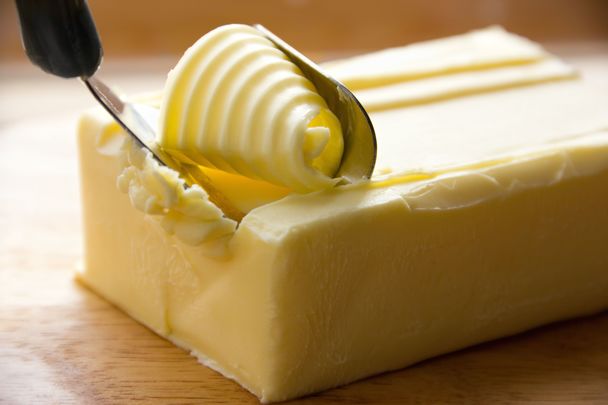BUTTER

Butter should also be dense and taste fresh. The moisture content should be dispersed in fine droplets so that the butter looks dry. The consistency should be smooth, so that the butter is easy to spread and melts readily in the mouth. Butter provides 7.2 calories/g.

HISTORY
Butter's origins go back about 10,000 years to the time when our ancestors first began domesticating animals. Today, butter in its many flavourful forms is the world's most popular fat. As a versatile spread, a delicious enhancer for so many foods, and the essential ingredient for baking, butter's simple goodness has no equal...
- The first reference to butter in our written history was found on a 4,500-year-old limestone tablet illustrating how butter was made.
- It is generally believed the word butter originates from the bou-tyron, Greek for “cow cheese”, however it may have come from the language of cattle-herding Scythians.
- Butter was used as food by ancient tribes of Asiatic India, as well as for burning in primitive lamps and smeared on skin to protect from the cold.
- In early times, unlike today, butter was so costly it was used in religious ceremonies. It still is today in India and Tibet.
- In ancient Rome, butter was valued cosmetically. Not only was it used as a cream to make skin smooth, but Greeks and Romans massaged it into their hair to make it shine.
- Much esteemed for its perceived healing properties, butter was also used in poultices to fight skin infections and burns. The ancient Egyptians even valued it as a cure for eye problems.
- During the T'ang Dynasty in China, clarified butter represented the ultimate development of the Buddha spirit.
- The ancient Irish, Scots, Norsemen and Finns loved and valued butter so much they were buried with barrels of it.
- Christian missionaries travelling in central Siberia in 1253 mentioned a traditional fermented drink, kumyss, which was served with generous lumps of butter floating in it.
- In Northern Europe, in centuries past, butter was credited with helping to prevent kidney and bladder stones as well as eye maladies. (This was probably thanks to butter's vitamin A content.)
- Sailors in Elizabethan times were guaranteed 1/4 lb of butter a day in their rations, and it was an old English custom to present newlyweds with a pot of this creamy delight as a wish for fertility and prosperity.
- source: https://www.dairygoodness.ca/butter/the-history-of-butter
- NUTRITION FACTS
- Nutrition Facts: Butter, Salted — 100 grams
FUNCTION
Butter plays a prominent role in the cooking of many countries, as it gives an unequaled taste to food and its ability to absorb helps to concentrate flavours. It is used particularly in sauces (Béarnaise, Hollandaise, kneaded butter, red), pastries (butter cream, puff pastry), creams and potages. It is a basic ingredient in breads, canapés and sandwiches.
In baking and grilling, butter must not be heated at a high temperature – it burns at a lower heat than oil or margarine, and its fat decomposes between 120 and 130.C. Butter heated at a high heat will have an indigestible and unappealing brownish colour. However, when combined with oil, butter will decompose less rapidly (heat the oil before adding the butter). Butter is more easily digestible fresh than melted, as it is still in its emulsified form.
CHARACTERISTIC
he quality of butter is based on its body, texture, flavour and appearance. It owes its characteristic and individual flavour to its own particular saturated fatty acid known as butyric acid. The colour and flavour may vary according to the type of cattle, season of the year, method of manufacture and amount of salt added. The colour of butter further varies with the content of carotenoids, which make up 11 to 50 per cent of the total vitamin A activity of milk. As the carotenoid content of milk normally fluctuates between winter and summer, butter produced in winter has a brighter colour. Carotene is added to ensure a uniform colour and consistent vitamin A content.
Butter should also be dense and taste fresh. The moisture content should be dispersed in fine droplets so that the butter looks dry. The consistency should be smooth, so that the butter is easy to spread and melts readily in the mouth. Butter provides 7.2 calories/g.
Comments
Post a Comment